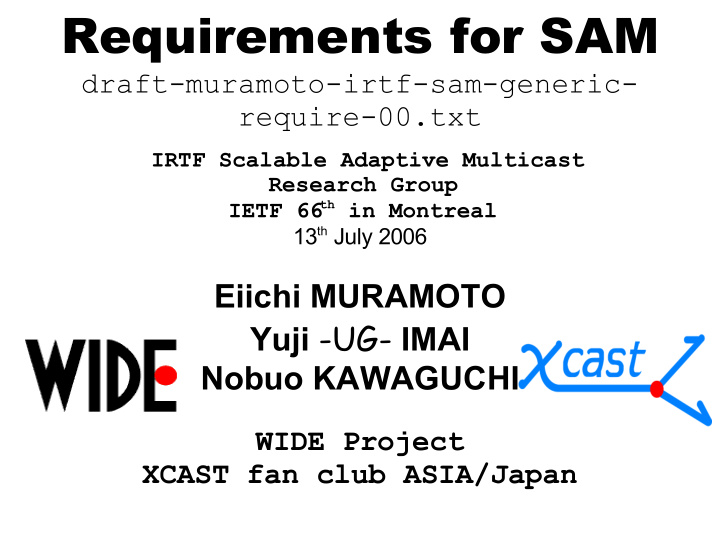



Requirements for SAM draft-muramoto-irtf-sam-generic- require-00.txt IRTF Scalable Adaptive Multicast Research Group IETF 66 th in Montreal 13 th July 2006 Eiichi MURAMOTO Yuji -UG- IMAI Nobuo KAWAGUCHI WIDE Project XCAST fan club ASIA/Japan
P2P/ALM/OM system already exists. ● Video & Audio – End System Multicast @CMU et, al. – Skype (~10 persons) ● File sharing – Gnutella Why we start – Bittrerant another efforts – Winny for this area?
A Brief History of the Internet by Prof. Ammar's Think Up A Networked Service Establish/Upgrade Connectivity To Provide Service Think Up A New/Improved Network Service The Service-Connectivity Cycle The Service-Connectivity Cycle "Why Johnny Can't Multicast: Lessons about the evolution of the Internet" (Presentation at NOSSDAV Keynote, June 2003)
A Tale of Two Scalability Schemes ● Multicast ● Replication/Caching – Requires infrastructure – Requires little support infrastructure support – No chance to evolve – – Followed services- No chance to evolve – Followed services- initial proposals were very initial proposals were very connectivity cycle connectivity cycle ambitious ambitious – In wide use today – No large-scale deployment today "Why Johnny Can't Multicast: Lessons about the evolution of the Internet" (Presentation at NOSSDAV Keynote, June 2003)
What we experienced recently. ● We know/believe ALM, OM, XCAST can drive “ service-connectivity cycle ”. – End user freely start distributions whenever they want. – They are satisfied once but will want much more . ● Anarchic usage of bandwidth applications is now about to broke the balance of the Internet eco-system. – As well as financial balance sheet of the tier-2, 3 ISPs.
Prof. Ammar warried about the revival of another “ MBone ”. Ideal Multicast Tree Data Flow Broadcast Tree "Why Johnny Can't Multicast: Lessons about the evolution of the Internet" (Presentation at NOSSDAV Keynote, June 2003)
Prof. Ammar warried about the revival of another “ MBone ”. MBone Data Flow MBoneTunnels "Why Johnny Can't Multicast: Lessons about the evolution of the Internet" (Presentation at NOSSDAV Keynote, June 2003)
The MBone Gives Multicast a Bad Reputation ● Unreliable ● Heavy Loss ● Low Bandwidth ● Unwieldy – Hard to manage ● Does not really save bandwdith! "Why Johnny Can't Multicast: Lessons about the evolution of the Internet" (Presentation at NOSSDAV Keynote, June 2003)
What was changed from “ Mbone “ to current P2P Multicast? ● Unreliable Redundant transmission ● Heavy Loss Bandwidth Infration ● Low Bandwidth ● Unwieldy – Hard to manage Self-organized ● Does not really save bandwdith! P2P Multicast overcome. But situation becomes ugly. "Why Johnny Can't Multicast: Lessons about the evolution of the Internet" (Presentation at NOSSDAV Keynote, June 2003)
Reality check. Urgent MS Update w/ reboot Winny (Self-organized P2P file distribution system) constantly wastes multi Gbit/sec at least by redundant file duplication, someone guess.
Can we really recover “ fairness ” & “ cooperativeness ”? ● In the age of Von Jacobson, community was so tight that everyone change TCP stack “Slow- started”. It was collaboration. ● Netscape TUNED their browser to accelerate the download speed using “socket pool”. ● MS TUNED initial WSS value to 2 to win the window growth competition. ● Today, some P2P file distribution systems spent bandwidth for previous caching and anonymity.
What we are challenging. ● Keep “ service-connectivity cycle ” for ease-of- use and end-user scalability. ● Make application & experiences rich by SAM. – Better quality, Rapidness & Robustness. ● Simultaneously, keep the Internet eco-system. – Co-exist with neighbors' traffic. – Invite ISP for collaboration ring to enjoy multicast goodness and help accelerate it. That's why we have to make our multicast Scalable & Adaptive .
Base requirements 1. Multicast capability – one-to-multi point – multi point-to-multi point 2.Service-connectivity cycle – Minimize starting-up cost of SAM, both at the end nodes and in networks.
Scalability requirements 3. Very large number of trees & groups in the Internet. – So that millions of humans and multiple- sensors can communicate.
Adaptivity requirements 4. Fast routing convergence – Catch up unicast routing path changes. When link or router failure. 5.Dynamic topology change – Mobile and MANET situation might be assumed. 6.Dynamics of group membership – it is necessary to assume frequent change of group membership.
Adaptivity requirements 7. Latency (Delay sensitivity) – The delivery path of the multipoint communication should be able to optimized to shorten the total transmission delay. 8.Dynamic topology change – Mobile and MANET situation might be assumed. 9.Congestion avoidance – To co-exists w/ other or oneself traffics. 10.Redundancy – In case of forwarding node failure or deserting.
Security requirements 11. Unexpected utilization of resources – Don't use the other's resource too much. 12.Authorization of group membership – Prevent malicious nodes from receiving the distributed packets. 13.Protect against DoS. – Prevent crackers from using SAM as embedded Botnet. 14.Encryption and key distribution
Considerations ● Comments & requirements from others. Thanx! – “efficiency of data distribution/transmission” by Jun Lei. – “Multicast should not artificially concentrate traffic on certain nodes or certain links.” by Rick Boivie – “common understanding on the requirements” is useful by Xiaoming Fu. ● No “one size fits all” approach. – Depends on individual applications, requirements for SAM are different. – Building block approach should be considered as well as RMT and so on.
Remained works ● Revising by comment immediately after THIS meeting. ● “Problem space” & “Existing problems” – Ex. Input from Global Information Grid ● “Explanation why requirements is important.” – with Jun Lei ? :-) Any other?
Recommend
More recommend